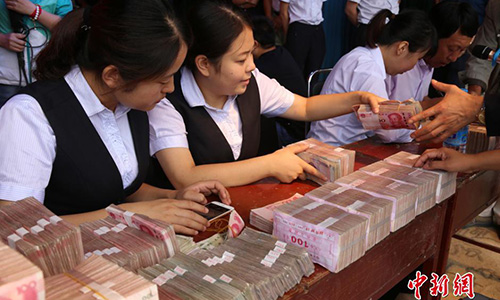HOME >> SOURCE
Moody’s touting Chinese debt risk barks up the wrong tree
By Zhou Qing Source:Global Times Published: 2019/12/18 21:38:40

About 5.6 million yuan (850,000 US dollars) was distributed on Saturday to 80 households who took part in a tree planting scheme in a village in Lintao County, northwest China's Gansu province. Photo: Chinanews.com
Global credit rating agency Moody's deliberately has turned a blind eye on piling debt in Western countries such as the US while touting the risk of Chinese corporate debt. Chinese corporate debt is the "biggest threat" to the global economy, says Moody's chief economist Mark Zandi, according to a media report.However, cherry picking the corporate debt does not reveal the whole picture of global debt pattern. Compared to China, the overall debt ratio of the US is an elephant in the room that rating companies like Moody's ironically overlooked. Among the over $240 trillion global debt in the first quarter of 2019, the US debt rose to $69 trillion, which is almost 30 percent of the total, while the number for China is $40 trillion, per International Institute of Finance report.
The US government debt has grown rapidly after the 2008 financial crisis. The asset held by the US Federal Reserve (Fed) to monetize debt skyrocketed due to the bailout and purchase of mortgage-backed securities during the crisis. Not to mention that the US corporate debt also hit a record high earlier this year.
Major global economic crises mostly stem from the US. Suppose another round of global economic recession looms on the horizon, the US, which has limited policy leeway and large Fed balance sheet, will be in a bad position and may drag the global economy into depression.
It seems that the US is the one who is hugging a ticking debt bomb. But it does not mean China should not be alert to increasing debt risks. There have been some cases of debt default of Chinese companies recently. The side effects of China's deleveraging effort last year are still lingering around. External factors including trade war uncertainties and a gloomy world economy have weighted on the Chinese economy and companies, putting more pressure on company liquidity. Also, due to an unsmooth monetary transmission mechanism, companies, especially small and medium-sized enterprises (SMEs) may face tight liquidity which drives up debt default risks.
How to reasonably allocate capitals and lower the fundraising cost for SMEs has been a challenge to countries worldwide. The Chinese policymakers have already stepped up to fix the problem by channeling more liquidity to SMEs. For instance, the one year loan prime rate (LPR) has been lowered three times, from 4.31 percent in August to 4.15 percent in November since the People's Bank of China launched new LPR quoting mechanism.
The Chinese government, which has a better fiscal health than the US can set up a safety net for those companies and improve regulations in terms of financing and bankruptcy. The liquidity predicament for certain Chinese companies is expected to be temporary and controllable. Moody's attempt to hold China accountable for global debt risk is barking up the wrong tree.
The author is a reporter with the Global Times. bizopinion@globaltimes.com.cn
Posted in: COLUMNISTS